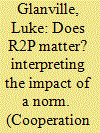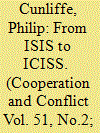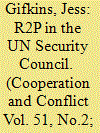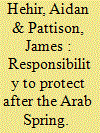|
|
|
Sort Order |
|
|
|
Items / Page
|
|
|
|
|
|
|
| Srl | Item |
| 1 |
ID:
145729


|
|
|
|
|
| Summary/Abstract |
There is a curious tendency among some scholars and commentators to denigrate the impact of the Responsibility to Protect (R2P). Drawing on constructivist scholarship that illuminates both the regulative and constitutive ways that norms matter and that explains how the effects of norms can be interpreted, I argue that the R2P norm has a real and observable impact on the behaviour of states. I demonstrate that this impact can be detected not only in instances of compliance, such as in Libya, but perhaps even more clearly in examples of violation, such as in Syria.
|
|
|
|
|
|
|
|
|
|
|
|
|
|
|
|
| 2 |
ID:
145732


|
|
|
|
|
| Summary/Abstract |
In light of the post-intervention crisis in Libya, this article revisits critically the vision of the Responsibility to Protect (R2P) offered in the 2001 report of the International Commission on Intervention and State Sovereignty (ICISS) – frequently taken as the conceptual bedrock for R2P doctrine. It is argued that the perverse effect of ICISS doctrine is to replace political responsibility with paternalism. The demand that states be made accountable to the international community ends by making states accountable for their people rather than to their people. The argument is developed across five critical theses. These include claims that R2P changes the burden of justification for intervention, that it usurps popular sovereignty in favour of state power, and that it diffuses post-conflict responsibilities. The article concludes that pre-emptive ‘human protection’ efforts risk crowding out questions of systemic transformation, i.e. what kind of an international order we want to live in.
|
|
|
|
|
|
|
|
|
|
|
|
|
|
|
|
| 3 |
ID:
145728


|
|
|
|
|
| Summary/Abstract |
It has been argued that consensus on the responsibility to protect (R2P) was lost in the United Nations Security Council as a result of the NATO-led intervention in Libya in 2011. This argument assumes that there was more agreement on R2P before the Libyan intervention than there was afterwards. Yet, a close examination of the Security Council’s use of language on R2P shows the opposite: R2P was highly contentious within the Security Council prior to the Libyan intervention, and less so afterwards. Not only has the Council used R2P language more frequently since 2011, but also negotiating this language has become quicker and easier. To demonstrate this I compare negotiations on Darfur with deliberations during and after the Arab Spring. Resolution 1706 on Darfur was the first time the Security Council referred to R2P in a country-specific resolution – and indeed it was the only country-specific resolution to refer to R2P before 2011 – making it an apt point of comparison. Via focused analysis on how the language used in Security Council resolution evolves over time, this article demonstrates that the Council has found ‘agreed language’ on R2P that is acceptable to members, both for thematic resolutions and country-specific resolutions. Language on R2P in Security Council resolutions has shifted from contentious to commonplace.
|
|
|
|
|
|
|
|
|
|
|
|
|
|
|
|
| 4 |
ID:
145731


|
|
|
|
|
| Summary/Abstract |
This article engages with the debate on the efficacy of the Responsibility to Protect (R2P) in the wake of the Arab Spring by articulating a defence of its role in preventing the commission, escalation, or recurrence of atrocity crimes. Taking as its starting point the claim by UN Secretary-General (UNSG) Ban Ki-moon that prevention remains the most important aspect of the principle of R2P, the article illustrates the extent to which prevention is embedded in R2P, the means by which it can be leveraged, and the obstacles to its operationalisation. The first section outlines why and how the prevention of the four crimes identified in the 2005 World Summit Outcome Document became so important to UN member states. The second section analyses efforts to implement the commitment to prevention within the UN, regional organisations, and individual states. The final section offers an explanation for why prevention is in fact a controversial practice – despite the universal rhetorical commitment to its prioritisation – and advances a series of steps which might be undertaken to advance it.
|
|
|
|
|
|
|
|
|
|
|
|
|
|
|
|
| 5 |
ID:
145727


|
|
|
|
|
| Summary/Abstract |
The Responsibility to Protect (R2P) has become the pre-eminent framework for discussing humanitarian intervention and issues related to human rights protection generally. Its origins lie in the 2001 report of the International Commission on Intervention and State Sovereignty (ICISS), which first proposed the notion of the ‘Responsibility to Protect’. Its adoption at the 2005 United Nations (UN) World Summit, with over 160 heads of state in attendance, has led to numerous inter-disciplinary debates within academia and beyond. The R2P has often been controversial, but the eruption of the ‘Arab Spring’ in late 2010 has constituted the concept’s most exacting test and prompted a further spike in interest in both its efficacy and desirability. The articles in this special issue assess the R2P in light of the events during, and debates surrounding, the Arab Spring. Together, they constitute a uniquely focused assessment of this significant and influential doctrine.
|
|
|
|
|
|
|
|
|
|
|
|
|
|
|
|
| 6 |
ID:
145730


|
|
|
|
|
| Summary/Abstract |
The emergence of the Responsibility to Protect (R2P) owed much to the need to enhance the UN’s ability to act forcibly in the face of the most extreme cases of gross human suffering. Too often in the past such responses were emasculated or thwarted by the necessity to successfully navigate the UN Charter’s prescriptions over the use of force, by the unwillingness of member states to provide military forces, or by a combination of the two. In accepting that certain types of inhuman activity can lead to the legitimate use of force within the UN Charter framework, the adoption of R2P appeared to resolve at least some of these problems, and as such it offered hope to those wishing to see the UN adopt a more assertive response to the grossest of human rights abuses. But, using stalemate over Syria as its backdrop, this article demonstrates the dubiousness of the claim that such a normative development can ever trump the hard edged political and strategic factors which determine when states will accept and/or participate in the use of force, and it suggests a radical solution to the dangers inherent in R2P’s intimate association with military intervention.
|
|
|
|
|
|
|
|
|
|
|
|
|
|
|
|
|
|
|
|
|